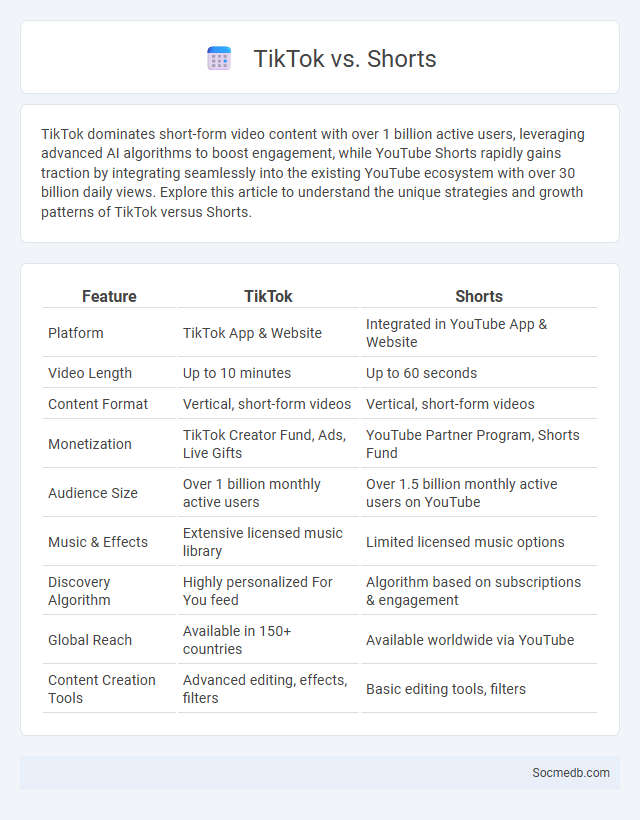
Photo illustration: TikTok vs Shorts
TikTok dominates short-form video content with over 1 billion active users, leveraging advanced AI algorithms to boost engagement, while YouTube Shorts rapidly gains traction by integrating seamlessly into the existing YouTube ecosystem with over 30 billion daily views. Explore this article to understand the unique strategies and growth patterns of TikTok versus Shorts.
Table of Comparison
| Feature | TikTok | Shorts |
|---|---|---|
| Platform | TikTok App & Website | Integrated in YouTube App & Website |
| Video Length | Up to 10 minutes | Up to 60 seconds |
| Content Format | Vertical, short-form videos | Vertical, short-form videos |
| Monetization | TikTok Creator Fund, Ads, Live Gifts | YouTube Partner Program, Shorts Fund |
| Audience Size | Over 1 billion monthly active users | Over 1.5 billion monthly active users on YouTube |
| Music & Effects | Extensive licensed music library | Limited licensed music options |
| Discovery Algorithm | Highly personalized For You feed | Algorithm based on subscriptions & engagement |
| Global Reach | Available in 150+ countries | Available worldwide via YouTube |
| Content Creation Tools | Advanced editing, effects, filters | Basic editing tools, filters |
Introduction to TikTok, YouTube Shorts, and Content Relevancy
TikTok and YouTube Shorts are leading platforms in the short-form video content space, attracting millions of daily active users with engaging, bite-sized videos. Content relevancy on these platforms hinges on trending challenges, popular music, and niche communities that drive high viewer interaction and shareability. Optimizing videos with relevant hashtags, timely topics, and culturally resonant themes significantly boosts visibility and user engagement.
Platform Algorithms: How Content Gets Discovered
Platform algorithms analyze your behavior, preferences, and interactions to prioritize content that matches your interests, increasing its visibility. These complex systems use machine learning to curate personalized feeds by evaluating factors like engagement rates, post relevancy, and trending topics. Understanding how algorithms work helps you optimize your content strategy for better discovery and audience growth.
User Demographics and Audience Behavior
User demographics on social media platforms reveal diverse age groups, with Millennials and Gen Z dominating usage patterns, while geographic and socioeconomic factors influence content engagement. Understanding audience behavior, including peak activity times, content preferences, and interaction types, enables precise targeting and improved marketing strategies. Your social media campaigns benefit significantly from analyzing these demographic insights to increase reach and engagement effectively.
Content Creation Tools and Features Comparison
Content creation tools on social media platforms vary significantly in features, catering to different user needs such as video editing, graphic design, and scheduling. Instagram offers intuitive in-app editing features like filters, stickers, and Reels for short-form videos, while TikTok provides advanced video effects, sound integration, and AI-based editing options. Platforms like Canva and Adobe Spark complement social media content creation with robust templates and design tools, facilitating professional-grade visuals optimized for various social networks.
Video Length and Format Differences
Social media platforms prioritize distinct video lengths and formats, with Instagram Reels supporting up to 90 seconds of vertical video, while TikTok allows videos up to 10 minutes but thrives on shorter, engaging clips under 60 seconds. Facebook supports various formats, including square and vertical videos, with a recommended length of 15 seconds to 3 minutes for optimal engagement. YouTube favors longer-form content and horizontal 16:9 aspect ratio videos, though Shorts provide vertical videos capped at 60 seconds, catering to quick, mobile-friendly consumption.
Engagement Metrics: Likes, Shares, and Comments
Engagement metrics such as likes, shares, and comments are critical indicators of your social media content's effectiveness and audience interaction. These metrics help measure how well your posts resonate with your target audience by quantifying approval, dissemination, and active participation. Monitoring engagement metrics allows you to refine strategies and boost your brand's online visibility and influence.
Virality Potential and Trends Propagation
Social media platforms amplify content reach through algorithms that prioritize engagement metrics such as shares, comments, and likes, significantly boosting virality potential. Trends propagate rapidly via network effects, where influencers and user communities accelerate content dissemination, creating exponential visibility within hours. Hashtags, challenges, and viral formats serve as key catalysts, enabling content to traverse diverse demographics and geographic boundaries efficiently.
Monetization Opportunities for Creators
Social media platforms offer diverse monetization opportunities for creators, including brand partnerships, sponsored content, and direct fan support through features like subscriptions and tipping. Leveraging algorithms and analytics tools enhances audience targeting and engagement, driving revenue growth. Emerging formats such as livestreams and exclusive content subscriptions provide additional income streams for creators.
Brand Marketing Impact and Relevancy
Social media platforms significantly enhance your brand marketing impact by enabling precise audience targeting and real-time engagement, which boosts brand visibility and customer loyalty. Leveraging data analytics on platforms like Instagram, Facebook, and Twitter allows for tailored content that resonates with user preferences, increasing relevancy and conversion rates. Consistent brand messaging across social channels strengthens your market presence and drives sustained consumer interaction.
Future Trends: Evolving Short-Form Video Landscape
The future of social media is increasingly dominated by evolving short-form video formats, with platforms like TikTok, Instagram Reels, and YouTube Shorts driving user engagement and content creation. Advanced AI-driven video editing tools and real-time interactive features are enhancing personalized viewer experiences, making short-form content more immersive and dynamic. Brands are leveraging these trends for targeted advertising, capitalizing on the rising demand for authentic, bite-sized videos that capture audience attention quickly in a saturated digital environment.
 socmedb.com
socmedb.com